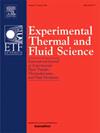Evolution of droplet freezing front and surface temperature on cold surface under forced convection
IF 2.8
2区 工程技术
Q2 ENGINEERING, MECHANICAL
Experimental Thermal and Fluid Science
Pub Date : 2025-01-10
DOI:10.1016/j.expthermflusci.2025.111410
引用次数: 0
Abstract
The evolution of freezing front and surface temperature in droplet freezing process under forced convection condition was studied. The influence mechanism of convective heat transfer on the droplet freezing front was explored through the surface temperature change. A prediction model for droplet freezing under forced convection was established by considering the effect of convective heat transfer. The results indicated that in the peak freezing mode, the rise of the freezing front is driven by the heat conduction of the cold surface, while in the peakless freezing mode, the freezing front will reach thermal equilibrium, and its movement is driven by the frost induced inter-droplet nucleation. Affected by the force-convective heat transfer, the temperature difference inside the droplet increases significantly. The higher droplet surface temperature on the windward makes the freezing front and isotherm tilt towards the windward. As airflow velocity increase, the larger convective heat transfer leads to slower temperature decrease in the solidification stage. By analyzing the freezing front moving process on the windward and leeward separately, the evolution of the freezing front and solidification time can be predicted accurately by the model for the peak freezing mode, and the calculated critical criterion for freezing mode transition agrees well with the experimental results.
强迫对流条件下冷地表液滴冻结锋与地表温度的演化
研究了强制对流条件下液滴冻结过程中冻结锋和表面温度的演变。通过表面温度的变化,探讨了对流换热对液滴冻结锋的影响机制。考虑对流换热的影响,建立了强制对流条件下液滴冻结的预测模型。结果表明:在峰值冻结模式下,冻结锋的上升是由冷表面的热传导驱动的,而在无峰值冻结模式下,冻结锋将达到热平衡,其运动是由霜冻诱导的液滴间成核驱动的。受力对流换热的影响,液滴内部温差明显增大。迎风面液滴表面温度较高,使冻结锋和等温线向迎风倾斜。随着气流速度的增加,对流换热量越大,凝固阶段温度下降速度越慢。通过分别分析冻结锋在上风和背风方向的移动过程,利用冻结峰模式模型可以较准确地预测冻结锋的演变和凝固时间,计算的冻结模式转变临界判据与实验结果吻合较好。
本文章由计算机程序翻译,如有差异,请以英文原文为准。
求助全文
约1分钟内获得全文
求助全文
来源期刊

Experimental Thermal and Fluid Science
工程技术-工程:机械
CiteScore
6.70
自引率
3.10%
发文量
159
审稿时长
34 days
期刊介绍:
Experimental Thermal and Fluid Science provides a forum for research emphasizing experimental work that enhances fundamental understanding of heat transfer, thermodynamics, and fluid mechanics. In addition to the principal areas of research, the journal covers research results in related fields, including combined heat and mass transfer, flows with phase transition, micro- and nano-scale systems, multiphase flow, combustion, radiative transfer, porous media, cryogenics, turbulence, and novel experimental techniques.
 求助内容:
求助内容: 应助结果提醒方式:
应助结果提醒方式:


